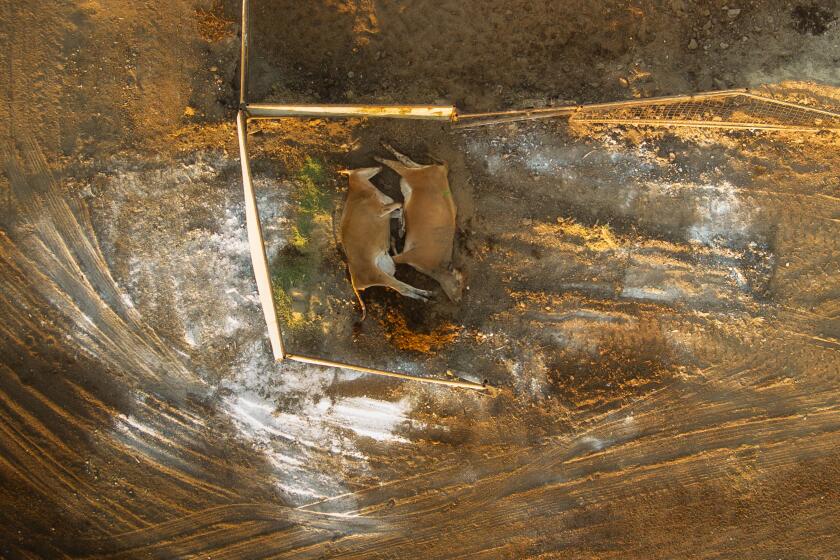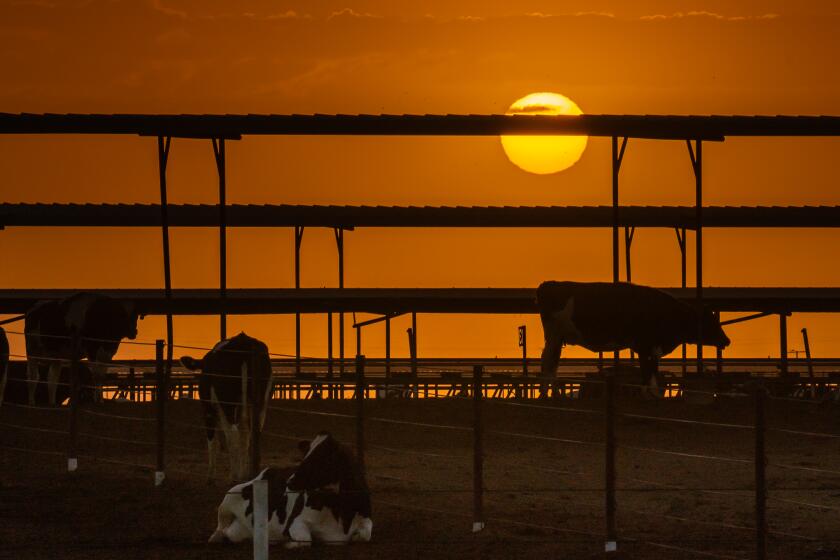
- Share via
- Swine are considered by health officials to be efficient influenza mixing bowls.
- The infected pig was not destined for commerical food production and federal officials say there is no concern about the safety of the nation’s pork supply.
Oregon state and federal officials confirmed Wednesday that H5N1 bird flu was found in a pig living in Crook County — the first such swine infection reported in the current outbreak.
The strain of bird flu virus in the pig is slightly different from the one that has been plaguing dairy cows in California and other states, which is known as B3.13. Instead, it is called D1 and probably originated in wild birds migrating along the Pacific flyway.
Both strains are H5N1; they just followed slightly different evolutionary trajectories, which is reflected in their genetic sequence.
Finding the flu virus in a pig, regardless of the strain, is a concerning development, scientists say, especially as human flu season begins.
“This is one big event that everyone has feared,” said Rick Bright, a virologist and the former head of the U.S. Biomedical Advanced Research and Development Authority.
Although California dairy farmers had heard about the H5N1 bird flu before it hit, none was prepared for the devastation it would cause in some herds.
Swine are considered by health officials to be efficient influenza mixing bowls: They are susceptible to both avian and human flu viruses and can potentially provide an opportunity for different viruses to exchange genetic materials and become a greater threat to humans.
“Experts and commentators have minimized the outbreak to date, saying, ‘but it’s not in pigs yet.’ Well, now it seems to be, and just in time for the other critical ingredient to brew a pandemic virus … seasonal human flu viruses,” Bright said.
He said it’s crucial that federal authorities move quickly and transparently.
“We cannot afford to keep playing a wait and see game,” he said. “We all know how quickly this virus can emerge and spread. We must immediately remove it from these farms, increase all surveillance, and begin planning actions for a larger response. ... We cannot afford to do wait and see … again. We need to act now.”
John Korslund, a retired U.S. Department of Agriculture veterinary epidemiologist, was a bit more circumspect.
According to officials, the infected pig was one of five living on a small farm. All pigs were tested and euthanized. Results for two of the other pigs were negative, while the others are pending. In addition, federal authorities say only “low viral levels” were detected in the samples.
Korslund said this suggests the virus may require close contact, such as shared water, to move.
“I’ll be more concerned if it travels by aerosol to a confinement building,” he said, adding that a pig serving as a mixing vessel is “not as likely in backyard herds — a bigger risk [is] in commercial herds where flu is more endemic.”
The Oregon farm, which is located in an area just east of Bend, is not a commercial operation, according to the U.S. Department of Agriculture. Its animals were not destined for commercial food production.
As a result, federal officials say, there is no concern about the safety of the nation’s pork supply. They also note that cooking foods properly and pasteurizing dairy products inactivates the virus.
Dairy industry experts say the virus entered California after local cows were shipped to another state and then returned to California.
The farm where the pigs were living is the same one where 70 infected “backyard birds” were tested and euthanized last week after H5N1 was detected. The farm is under quarantine and the state’s department of agriculture is surveilling the area.
Oregon officials said that while there were five pigs on the farm, they did not live together. Three of the pigs, including the one that tested positive, roamed the farm at will. The other two, described as “tea pot” pigs, were housed separately.
Both those pigs were given preliminary tests for the virus, and in at least one of the two, the results were suspicious. So the pigs were killed and their bodies were sent to the USDA’s National Veterinary Services Laboratories in Ames, Iowa. Those tests are pending.
Ryan Scholz, state veterinarian with the Oregon Department of Agriculture, said in a news conference Wednesday that those pigs were housed with the infected chickens, so it’s likely that’s where they picked up the virus — not necessarily from the other pigs.
He said the three roaming pigs were large, although one was small enough to go under fences and conceivably could have interacted with the teapot pigs.
Other species of animals, such as sheep and goats, were also on the farm but have not shown signs of illness.
None of the people on the farm have shown signs of illness.
However, Dean Sidelinger, Oregon’s health officer and state epidemiologist, would not say how many people were on the farm, or whether they had been tested.
Both officials said that the risk to the public remains low and that the food supply is safe.
As the range and incidence of valley fever grows, public health officials are struggling to warn visitors of the risk.
In the lasttwo weeks, there have been several outbreaks in commercial and backyard flocks in British Columbia, Washington and Oregon. California’s state veterinarian, Rebecca Jones, told The Times on Tuesday that a small backyard flock in Santa Rosa was also infected by the D1 strain.
That flock is not listed on the USDA’s website.
In addition, two commercial chicken farms in California’s Kings County, and a backyard flock in Tulare County, were reported infected on Tuesday. Again, the particular strains of H5N1 in those birds have not been identified.
However, it is likely to be this new wild bird variant.
“Based on recent diagnostic results, it’s apparent that migratory waterfowl are moving this new ‘D’ genotype down the Pacific flyway,” said Bryan Richards, the emerging disease coordinator at the U.S. Geological Survey’s National Wildlife Health Center.
Scientists are frustrated that genetic sequencing has not been forthcoming on some of these latest outbreaks, especially as outbreaks in poultry, cows and other animals continue to pop up.
On Wednesday, eight herds in Utah were confirmed positive for H5N1 — although sequencing data are not yet available.
According to the USDA, there have been 393 herds infected with H5N1 since March across 14 states — not including Oregon. Almost half of those — 193 — are in California.
With the addition of the Utah herds, which have not been added to the USDA tally, that makes 401 herds across 15 states.
Asked if a new strain of H5N1 in the mix was going to complicate the situation, Maurice Pitesky, an associate professor with a research focus on poultry health and food safety epidemiology at UC Davis, said, “yes.”
“This is year three of migration, where the virus seems to be coming back down,” via birds that summered in the Arctic and swapped viruses, he said. “If that keeps happening, it makes it much more challenging to stop.”
He said that a few years ago, he worked on a computer model that could predict where the virus would show up as birds migrated south. He said it worked, and now people are asking him to develop another.
“I can’t,” he said. “It’s too complex now. Now it’s in urban wastewater, it’s in wild mammals. It’s in dairy cows. It’s in song birds. It’s in waterfowl and shore birds. It’s in marine mammals. ... We’ve never had anything like this before at a species level, at a geographical level, and at a food security level. Wow.”










